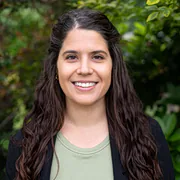Sorrow and hope in the Harz: How people are responding to the transformation of their forest
5 June 2025, by Inga Janina Sievert

Photo: Inga Janina Sievert
How do you feel when you see the status quo in the Harz? Shock or sadness at the countless withered spruces? Hope, when you see a single green tree? Or nostalgia, because you’ve been atop the Brocken before? Individual perspectives on the dying trees can influence e.g. whether and how people support the forest or climate protection in the future. At the University of Hamburg’s Cluster of Excellence, I’ve been investigating the question of how people living in the Harz experience this change, and which emotions they associate with it.
As an anthropologist, I accompany forestry workers, firefighters and national park employees on the job; I’ve e.g. joined them on hunts and spoken with local politicians and residents. What do people see as the cause of the problem, how do they cope with the dieback, and what do they expect tomorrow to bring?
For the majority of those surveyed, the forest is disappearing due to a combination of factors: Most often, they cite anthropogenic climate change, extreme weather events, bark beetle infestations, and poor management. Whereas many of them see the status quo as a crisis and threat, some see it as an opportunity to lastingly reshape the forest. Their perspectives depend to a great extent on their individual experiences. Yet everyone I met in the woods was emotionally moved by the issue.

The reactions range from mourning, angst, worry and anger to hope and optimism. The closer their ties to the forest and the more options they see, the more hopeful they are. In many cases, they have conflicting emotions: The desolate forest saddens many of them and in some cases, due to the heavier workload, can lead to depression and burnout. As Jörg, a forester I spoke with, put it: “It goes straight to your heart. So many problems! It can really get you down.”
At the same time, many people stressed how important it was to stay optimistic so that they could keep doing their job. Some of those surveyed linked their own experiences with memories of crises that were overcome in the past; this cyclical view gives them hope. I mostly encountered angry reactions from local politicians, some of them directed at the national park. Local ties are particularly important to those surveyed and empower them, while the global discourse on climate change is less of a factor.
And what about the future? According to Reinhardt, a national park employee: “The days of the dark spruce forests are gone for good.” While no single species known can save the forest, there’s a consensus that mixed forests have to replace the monocultures. In commercial forests, conifers are most often the top choice – they grow quickly, helping keep up with the considerable demand for wood.
The national park’s goal: a mixed beech forest. Here, mother trees are being planted, which will hopefully spread on their own. A combination of natural seed formation and sowing seems promising, as it helps produce trees that are optimally suited to their location and climate. The reforestation efforts will take roughly twenty more years – a costly and involved process. Seeds and planters are in short supply. But even if sowing is something new in the German forest, it is now giving many people hope. They agree that, when all is said and done, their forest will be a very different one, much younger and more diverse.
More Information
Dr. Inga Janina Sievert investigates how climate futures are socially constructed. She worked at the Cluster of Excellence for Climate Research CLICCS at the University of Hamburg until fall 2024.
Newspaper: This article was first published as a guest article in the Hamburger Abendblatt as part of a monthly series on climate research. Find all articles of the series here. Find all articles of the series here.


